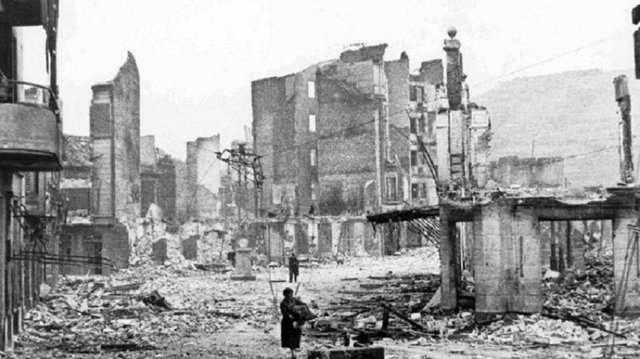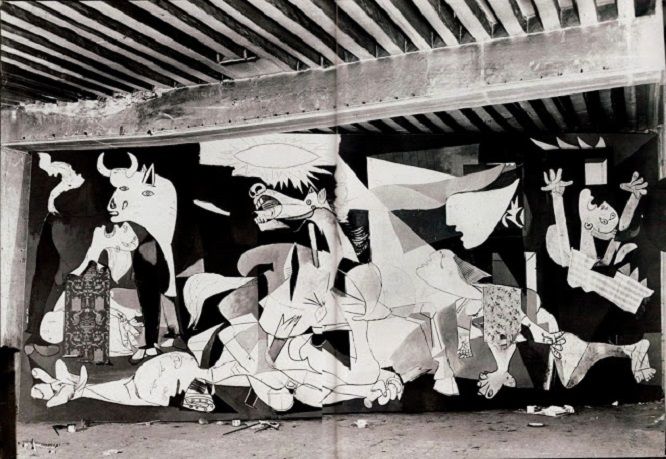Why "Guernica" is Picasso's most significant paint?
During the unleashed Civil War between the Second Spanish Republic and the opposition military dictatorship headed by Francisco Franco, the Spanish Republic ordered Picasso and several other famous artists to create the Spanish Pavilion at the World Exhibition in Paris in 1937. This is how the legendary Guernica - a painting inspired by the bombing of the peaceful Basque village of Guernica , which Franco's German allies are crashing into the ground. The paint today is located in the Queen Sofia Art Center, Madrid. And although many Picasso paintings are crowned masterpieces, such as the Avignon ladies, for example, which is supposed to be the beginning of the movements in abstract art with Cubism, Guernica is the only one to be a fruitful work of the artist. But why does this paint remain in the minds of generations?
Experiments in Picasso's art that lead to Guernica
In the mid-20's of the last century, a time when Picasso was fascinated by surrealism, he still painted interiors with still-life - musical instruments and fruits, showing the artist's pleasure. Anne M. Wagner, a curator at an exhibition in the Queen Sofia on the occasion of the 80th anniversary of the painting, tells that interiors soon awakened his feeling of claustrophobia, and the sense of pleasure disappeared. This change is taking place against the backdrop of the efforts of the United States and Europe to recover from the devastating First World War and in the years before the Great Depression. In this period, Picasso and surrealists explore the dark side of the human psyche. Picasso knew well that terror, tragedy and violence were also part of the man, and he strongly believed that psyche was the place where one untied his subconscious. The painting Les Trois Danseuses from 1925 is an excellent example of his works of that period. (Later in his life, Picasso considered her best work.) "Wild paint, somehow filled with surplus," Wagner says. So the creator replaces the still-life with female bodies. Famous with his connections, the Spanish virtuoso usually portrays his lovers with love in his personal works, but these images differ greatly from his public ones. In his public pictures, he rather treats them in their role as traps or machines, how they could be indicators of a different reality, and how they could be monstrous. In the years immediately before the appearance of Guernica his paintings testify to the symbolism that can be achieved through the manipulation of the female body - experiments that find their solution in Guernica . Despite the famous incredible speed Picasso creates for Guernica , it does not appear from nowhere. It is the result of the artist's many years of productiveness as well as his personal attitude to Spain's politics - the place where his family still lives.
Order of the Spanish Republic
Against the backdrop of the German and Soviet pavilions at the World Exhibition in Paris in 1937 - giant architectural demonstrations of power, the Spanish Republic, in need of financial support, chooses a modest but effective construction that stands out with world-class art. Picasso was given the mural painting assignment in January of that year. Although the Republic has the intention of staking the political ideas of the anti-fascist regime into the works, Picasso's original plan is not that. According to Wagner, the artist did not have a clear idea of the work, but from that time his sketches were depicted, depicting a studio artist standing against a naked model leaning against a sofa. But a tragedy makes him change the course.

The ruins of Spanish Basque town of Guernica after it was bombed by Germans in 1937 source
The bombardment of Guernica and the painting of the same name
On April 26, 1937, Franco ordered the Nazi Legion Condor (hired from Germany) to bomb the small town of Guernica . Market day, regular citizens, most women and children, are walking around town squares. Being the first democratic city in the Basque region, Guernica is a symbolic destination. The brutal bombing, which kills hundreds (the disputed number but reports vary between 200 and 1700 people) and injures over 900 others, is the first case in the Civil War to attack an unprotected city. The Spanish civil war is the first of its kind to be reflected in journalistic photography, showing the general public what is happening with the bodies of civilians - women and children. Like many others, on April 27, Picasso unfolds his morning paper in Paris and finds devastating pictures of the destruction of Guernica . Although he was politically active (he created works such as Franco's Sleep and Lying, which helped raise funds for the Republic), the case really rocked him and on May 1 he started building new sketches for the order. In the middle of June, the Guernica was completed and in July it was delivered to the Republic Pavilion. The work quickly became the center of attention surrounded by Alexander Calder's sculpture and a painting by Jean Miro.
Paint of the human tragedy
Guernica depicts a loose tangle of six human figures (four women, male and child), horse and bull. The action takes place within a claustrophobic interior with a low ceiling, under a lamp that seems to burst out of light. The scene clearly reads an emotional and physical consequence of war and violence. Picasso never gave an explicit explanation of the symbolism behind each of the pieces in Guernica : "Let the audience decide what to see," he said. Often, it was perceived, literally. At the same time, however, historians and art critics have been struggling to recognize the intentions behind each stroke for decades. The most direct are perhaps the messages in the distorted expressions of women suffering from physical agony and mental anguish. "It is obvious that deformations are Picasso's tools to portray pain and suffering," Wagner explains. The artist portrays their despair through sharp tongues, and their sorrow in the eyes, shaped like tears. The lamp is often read as a symbol of a bomb, but others take the shape of an eye (a bulb like an iris) as a hint of God's eye. Bull and horse tolerate different interpretations. Most are related to the role of animals in traditional Spanish bullfighting, where horses are often accompanying victims and the bull is wounded to death. Others say that the lack of emotional and physical expression of suffering in the bull means that it is the emblem of Franco or fascism. Thirdly, the bull, as a symbol of Spanish history, is here a static and steadfast witness of the tragedy.
Guernica in front of the society
After the show, Guernica is touring Europe. After the end of the war and Franco's victory, the paint continued to travel, raising funds for the refugees who had left Spain. Guernica became part of an exhibition at MoMA (Museum of Modern Art, New York), and Picasso ruled the museum as its guardian. By 1958, the paint continued to travel, but MoMa then decided to keep it in good shape. Over the years, Guernica has become a symbol of all those places where unprotected civilians have been attacked - Dresden, Berlin, Hiroshima, and others. Reproductions of the masterpiece appear during protests around the world, from Kolkata to Ramallah and South Carolina.
The Heritage of Guernica
Picasso understands well the political potential of Guernica . Since the beginning of the Second World War in 1939, Picasso has been observed by the Nazis at least precisely because of the strong influence of Guernica . They tell how a Nazi soldier visited Picasso's studio in Paris, pointing to the reproduction of the painting, and asked, "Did you do that?" And Picasso replied, "No, you were." The artist knew he had done something meaningful and had to protect him. He obtained a legal document prohibiting the return of Guernica to Spain until the establishment of a democratic regime. In 1981, 6 years after Franco's death and 8 years after the death of Picasso, Guernica finally returned to Spain but was shown under armored glass. The glass was removed only in 1995. Picasso creates other politically significant works later, but no one has been able to produce such a response. With its message understood by the whole world, Guernica leaves a mark on humanity. According to Wagner: "Extraordinary phenomenon for Picasso and the history of art, republican art, protest art and the human species."


Les Trois Danseuses
google search:
"Wild paint, somehow filled with surplus,"
Really interesting paint :D
thanks for posting
You are welcome :)
I find looking at photos of the creation of this painting to be just as powerful as the finished work. He said to Dora Maar who photographed the painting as it was being created, “it would be interesting to use a camera to fix not the stages of a painting, but its metamorphosis.”
More of the photos:http://www.artnewsblog.com/dora-maar-photographs-picassos-guernica/
Very interesting. Thank you :)
Bonjour.
Quelle magnifique œuvre d'art !
Est ce que c'est vous qui l'avait fait ?
Bonne journée à vous mon amie .
You are welcome :)
Nice picasso art
Guys please upvote me my reputation is down due to copyright so guys please help me
thanks